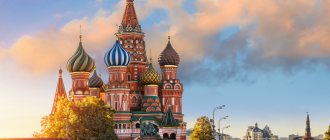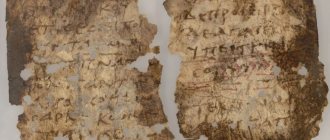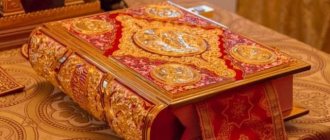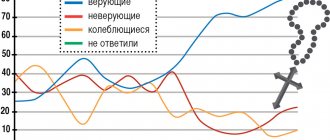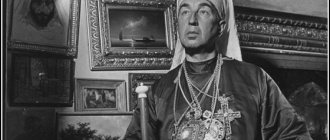List of false priests
1. Bakanin Vladimir Vasilievich
He calls himself “Hieroschemamonk Demetrius”, he independently conducted and continues to operate in the territory of the Shuya and Moscow dioceses, and has also been spotted in Belarus. According to the official statement of the Shuya diocese, he is engaged in fraudulent activities.
2. Lipin Alexander Pavlovich
Former deacon of the Vologda diocese, defrocked in 2004. He joined the split of the Sekachevites (Seraphim-Gennadievskaya branch of the RKTs IKh). Now he calls himself “Archpriest of the ROCOR.”
3. Makhov Mikhail Sergeevich
Former archpriest of the Ivanovo diocese, defrocked in 2010. Nevertheless, he continues to position himself as a priest.
4. Kirsanov Sergey Vladimirovich
He calls himself a cleric and a monk, also says that he “heads a monastery,” and publishes photographs of himself in the schema. He was expelled from PSTGU and was not ordained.
5. Shlyakhov Petr Stepanovich
He calls himself “hieromonk Anthony.” According to him, he was tonsured a monk and ordained to the priesthood by the former Bishop of Chukotka Diomede in 2007. He was banned from ministry in 2008.
6. Ageev Eduard Anatolyevich
Calls himself “Bishop Sergius.” According to him, he was ordained to the priesthood by the former Bishop of Chukotka Diomede in 2008. Subsequently, Ageev created a schismatic structure, where he positions himself as a bishop.
7. Kucherov Sergey Ivanovich
He calls himself “hieromonk Michael.” “Ordained” by Eduard Ageev, who calls himself “Bishop Sergius.”
8. Filippov Veniamin Evgenievich
He previously called himself “hieromonk Eustratius”, now he calls himself “schema-archimandrite Daniel”. Former priest of the Tula diocese, defrocked in 2009. He joined the schism of the former Bishop Diomede, and later began to call himself “unremembered.”
9. Golovin Vladimir Valentinovich
He was defrocked in 2021. Despite the ban, the clergy continues to preach on the Internet.
10. Romanov Nikolay Vasilievich
Former schema-abbot of the Yekaterinburg diocese. In 2021 he was defrocked and excommunicated from the Church. Nevertheless, he continues to perform divine services and positions himself as a clergyman.
Contacts
Moscow, Andreevskaya embankment, 2
+7
Moscow, Novovagankovsky lane, 7
+7
How is the Russian Church governed? The executive authorities of the Patriarch and the Synod in the twentieth century. Part I
The first meeting of the Holy Synod of the Russian Orthodox Church after the election of His Holiness Patriarch Kirill, held on March 31, 2009, can fully be called historical.
It began to implement the reform of the executive authorities of the Moscow Patriarchate and the Holy Synod, the need for which has been discussed in church circles for at least the last decade[1]. The modern charter of the Russian Orthodox Church includes among these bodies the institutions of the Moscow Patriarchate, that is, those that are led directly by the Patriarch, and the Synodal institutions - departments, councils, committees and commissions reporting to the Synod. Only the Moscow Patriarchate and the Synodal institutions, as stated in the same charter, “have the exclusive right” to represent the Patriarch and the Synod “within the scope of their activities.” Because of this, these institutions turn out to be, perhaps, the most visible part of the church body for society and the state. They act as their main counterparties in dialogue with the Church, put the Church into action as an institution, and serve as its brain. In order to fully appreciate the meaning and significance of the transformations that began at the end of March, it is necessary to take a retrospective look at how and under what conditions the system of church government bodies of the Russian Church developed in the past century. Patriarchal governance between legitimacy and legality
The first one and a half to two decades of the twentieth century for the Russian Orthodox Church were marked by the maturation and implementation of a global reform of the highest church administration. Local Council 1917-1918 put an end to the 200-year period of synodal, essentially secular government of the Church and restored its natural system of patriarchal government. The restoration of the Patriarchate was etched in the annals of history as the main act of the Council. It was the Council that provided the young institution of patriarchal power with the necessary legitimacy. However, he did not have time, and could not, complete the reform he had begun. It was necessary to build new effective institutions of higher church administration and debug their work. This was the most important task that faced the Russian Church at the beginning of the century. This required time, which she did not have.
The Bolshevik revolution confronted the Church with the necessity of survival. The task of implementing the reforms of church governance outlined by the Council was not removed from the agenda, but was postponed indefinitely. At the turn of the 10-20s, the Church, the bodies of its central and diocesan administration, actually found themselves in the position of illegal organizations from the point of view of the Soviet regime (and therefore potentially counter-revolutionary). During the campaign to confiscate church valuables in 1922-1923. the authorities consciously used the “illegal” position of the Church to put pressure on its hierarchy. Thus, the Orthodox Russian Church was faced with the need to seek means of legalizing itself and its governing bodies. This was necessary for two reasons. The first was that the illegality of church governing bodies exposed their members to a constant threat of reprisals. The second reason was connected with the first and for many church leaders was of paramount importance. It consisted in the fact that the anti-canonical renovation movement received legal status from the authorities. In addition, the Renovationists achieved recognition as the main representatives of the Russian Church by some Eastern Patriarchs. In this situation, the prospect of the Russian Church turning into a heretical renovationist community in the early 20s was seen as quite real[2].
Simultaneously with the crisis of legality, the governing bodies of the Patriarchal Church faced a crisis of legitimacy. The problem was that, according to the definitions of the Council of 1917-1918. The bodies of the highest church government, the Holy Synod and the Supreme Church Council, were partially to be elected at the Local Council. But by the beginning of 1919, the actual composition of these bodies had decreased by half, and in 1921 their term of office expired. At the same time, the Church did not have the opportunity to convene a new Council under conditions of persecution. As a result, during these years a system of church government was formed, built on the principle of unity of command, in which more and more functions were concentrated under the Patriarch[3]. Some researchers even talk about a forced change in the model of higher church governance: from a collegial one, headed by the Patriarch, to a completely patriarch-centric one[4]. The crisis of the legitimacy of church governance became especially acute after the death of Patriarch Tikhon. Now not only the hierarchs, but also ordinary believers, the need to convene a Council to elect a new primate of the Church was clear. However, the authorities linked permission to convene it with the cessation of the “counter-revolutionary” activities of the Church and with a number of concessions on its part. Legality and legitimacy - Scylla and Charybdis of church history 1917-1943. — for a long time became the main concern of the church authorities of the Orthodox Russian Church. Under these conditions, the effectiveness of the bodies of higher church government faded into the background. The work of the departments created under him (administrative, financial and economic, missionary council) was reduced to a minimum.
Only in 1927 was an important step taken towards overcoming the crisis of legality[5]. The situation with the search for the legitimacy of church governing bodies was more complicated. From this point of view, 1927 became fatal for the Russian Church. Permission to convene the Council, which Metropolitan expected to receive. Sergius (Stragorodsky), issuing his “Declaration” of loyalty to the Soviet government on July 29, 1927, was never received. A number of opposition movements questioned the legitimacy of the actions of Metropolitan. Sergius and the Synod formed by him. Only in 1945, after the conciliar election of Metropolitan. Alexy (Simansky) and thanks to his policy to overcome domestic and foreign schisms, the legitimacy of church governance was restored.
Patriarch Alexy I (Simansky) and the first system of patriarchal government
Contemporaries did not hesitate to call His Holiness Patriarch Alexy I the great Patriarch. This was indeed the case. And not only because his patriarchate was the longest in the history of the Russian Church. He was one of those charismatic persons who symbolized the Russian Church, in whose face it recognized itself. In addition, he managed to create an effective, legitimate system of legal higher church government, which operated for almost 15 years and whose main feature can be described as patriarchal centrism. This feature was inherited from the period of the 10s - 30s, when the unity of command of the primate allowed the Church to resist attempts by the authorities to destroy it from within[6].
According to the Regulations on the Administration of the Russian Orthodox Church of January 31, 1945, the Russian Church “is headed by the Patriarch... and is governed by him together with the Holy Synod.” There were six members of the Holy Synod: three permanent and three temporary. Synodal departments were just being created (§22 of the Regulations on Management). Then they were all located in Chisty Lane, next to the Patriarch’s residence. This made it easier for him to control their work, and department employees felt like they were his employees. The Small Synod, which included the most active bishops of the Russian Church, was a compact and mobile structure. Such powerful figures as Metropolitans John (Sokolov; †1968) and Grigory (Chukov) completely balanced the ardent Metropolitan. Nikolai (Yarushevich).
In the 40-50s there was still no need to create a powerful apparatus within the Patriarchate and within each department. Formed in April 1946, the Department of External Relations consisted of three people: the chairman, Metropolitan. Nikolai (Yarushevich; †1961), assistant and typist. The diocesan bishop could afford to receive everyone who came to him with a petition, and the Patriarch could personally read all letters addressed to him. It turned out that each of the areas of church activity was handled by a specific person with a few assistants: Met. Grigory (Chukov; †1955) was the “Minister of Education,” Metropolitan. Nicholas - “Minister of Foreign Affairs”, Protopresbyter Nikolai Kolchitsky (†1960) - “head of the administration” of the Patriarch and responsible for contacts with the authorities. Let us take into account the fact that all of them had enough pre-revolutionary education in order to cope with their work efficiently.
At the same time, the Patriarch could give each of his employees a special assignment that went beyond the scope of his direct duties. In the spring of 1945, Met. Gregory was the patriarchal emissary to Estonia. His task was to negotiate with local schismatics about reunification with the Patriarchal Church and, if their outcome was favorable, to carry out an act of reunification[7]. In the early 60s, on behalf of Patriarch Alexy Metropolitan. Leningradsky Pimen made a secret night trip from Odessa to Pochaev to obtain truthful information about the state of the Pochaev Lavra[8]. The directness of relations within the highest church administration contributed to its consolidation and effectiveness.
The Patriarch managed to concentrate the intellectual forces of the Russian Church under the Patriarchate. The Moscow Theological Institute, the future Theological Academy, according to the Regulations on Management, was “under the immediate jurisdiction of the Patriarch” (§10). It was possible to attract specialists with pre-revolutionary education to work at the institute. They were often involved in the development of specific steps of the Patriarchate (for example, the Conference of Heads and Representatives of Orthodox Churches in 1948). Another intellectual center was the Leningrad Academy, recreated under the direct patronage of Metropolitan. Grigory (Chukov).
The consolidation of church administration was also helped by the special psychology of the people involved. The main personnel support of Patriarch Alexy were bishops, trained before the revolution and hardened by years of persecution. They were staunch supporters of the line of Metropolitan. Sergius on the legalization of church government. They perceived the change in attitude towards the Church on the part of the state in the 40s as a historical victory for the cause of Patriarch Sergius and their own. Triumphant intonations can be heard in many documents of the Patriarchal Church of the second half of the 40s. As a result, even if there were various currents within the episcopate[9], in the face of the state the Church acted as a single institution centered in the Patriarchate.
The effectiveness of the highest church administration in those years was reflected in the fact that it was able to develop a strategy for the life of the Church and adjust it in accordance with changing conditions. Thus, the second half of the 40s was marked by the “offensive” of the Church, inspired by the Patriarchate: against the backdrop of its active international activities, which corresponded to the foreign policy plans of the Soviet leadership, its demands on the authorities, aimed at expanding church life, also became more insistent. After 1948, the Church switched to “defense” and again the Patriarch himself indicated a new direction: “Even though everything changes around us, we must remain the same as we were hundreds of years ago. Let our immutability and insubordination to the spirit of the times symbolize the eternity of the Church”[10]. It was clear to the episcopate and government bodies: the political will of the Patriarchate was concentrated in Chisty Lane, at the residence of the Patriarch. This was clearly demonstrated by the events of February 1960 associated with the speech of Patriarch Alexy at the Conference of the Soviet Public for Disarmament. Whoever was the author of this speech, the final authority to make the decision was undoubtedly the Patriarch himself.
[1] See, for example: Beglov A. How is the Russian Orthodox Church governed? A brief critical analysis of the activities of the departments of the Moscow Patriarchate over the past 55 years // NG-religions. November 29, 2000 No. 22 (69). S. 1, 3.
[2] For more information about the crisis of legality, see Beglov A.L. Soviet legislation regarding the Russian Orthodox Church in the 1920s-1940s: fluctuations in the boundaries of legality // Religions of the world. 2004. M., 2004. S. 211-214; Beglov A.L. In search of “sinless catacombs.” Church underground in the USSR. M., 2008. P. 31-39; Mazyrin A.V. Legalization of the Moscow Patriarchate in 1927: hidden goals of the authorities // Domestic history. 2008. No. 4 (July - August). pp. 114-124.
[3] Kashevarov A. N. Orthodox Russian Church and the Soviet state. (1917-1922). M., 2005. S. 251, 346-347; Safonov D.V. Unity of command and collegiality in the history of the highest church administration of the Russian Church during the patriarchate of St. Tikhon // Theological Bulletin. Vol. 8-9. Sergiev Posad, 2008-2009.
[4] Ibid.
[5] For more details see: Beglov A.L. Dioceses and bishops of the Russian Church in 1927, or why did Metropolitan Sergius (Stragorodsky) begin to move diocesan bishops? // Alpha and Omega. 2007. No. 2(49). pp. 169-189. In historiography, there is an opinion according to which the formal registration of church government bodies in 1927-1928. was never achieved. See: Mazyrin A.V. Legalization of the Moscow Patriarchate in 1927: hidden goals of the authorities // Domestic History. 2008. No. 4 (July - August). pp. 114-124. From this point of view, we can talk about the complete overcoming of the crisis of legality only from 1943-1944.
[6] Safonov D.V. Unity of command and collegiality in the history of the highest church administration of the Russian Church during the patriarchate of St. Tikhon.
[7] Archpriest Vladislav Tsypin. History of the Russian Church. 1917-1997. M., 1997. pp. 319-320.
[8] Bishop Sergius (Sokolov). It would be true to say... Novosibirsk, 1999. P. 89-90.
[9] Shkarovsky M.V. Russian Orthodox Church under Stalin and Khrushchev. State-church relations in the USSR in 1939-1964. M., 1999. P. 347.
[10] Chumachenko T. A. State, Orthodox Church, believers. 1941-1961. M., 1999. S. 69, 77; Archpriest Vladislav Tsypin. History of the Russian Church. 1917-1997. M., 1997. P. 331.
